There are 6 items in your cart.
Total products: 114.72
Taxes 0.00
Total: 121.72 (tax excl.)

 Salman Faris
Salman Faris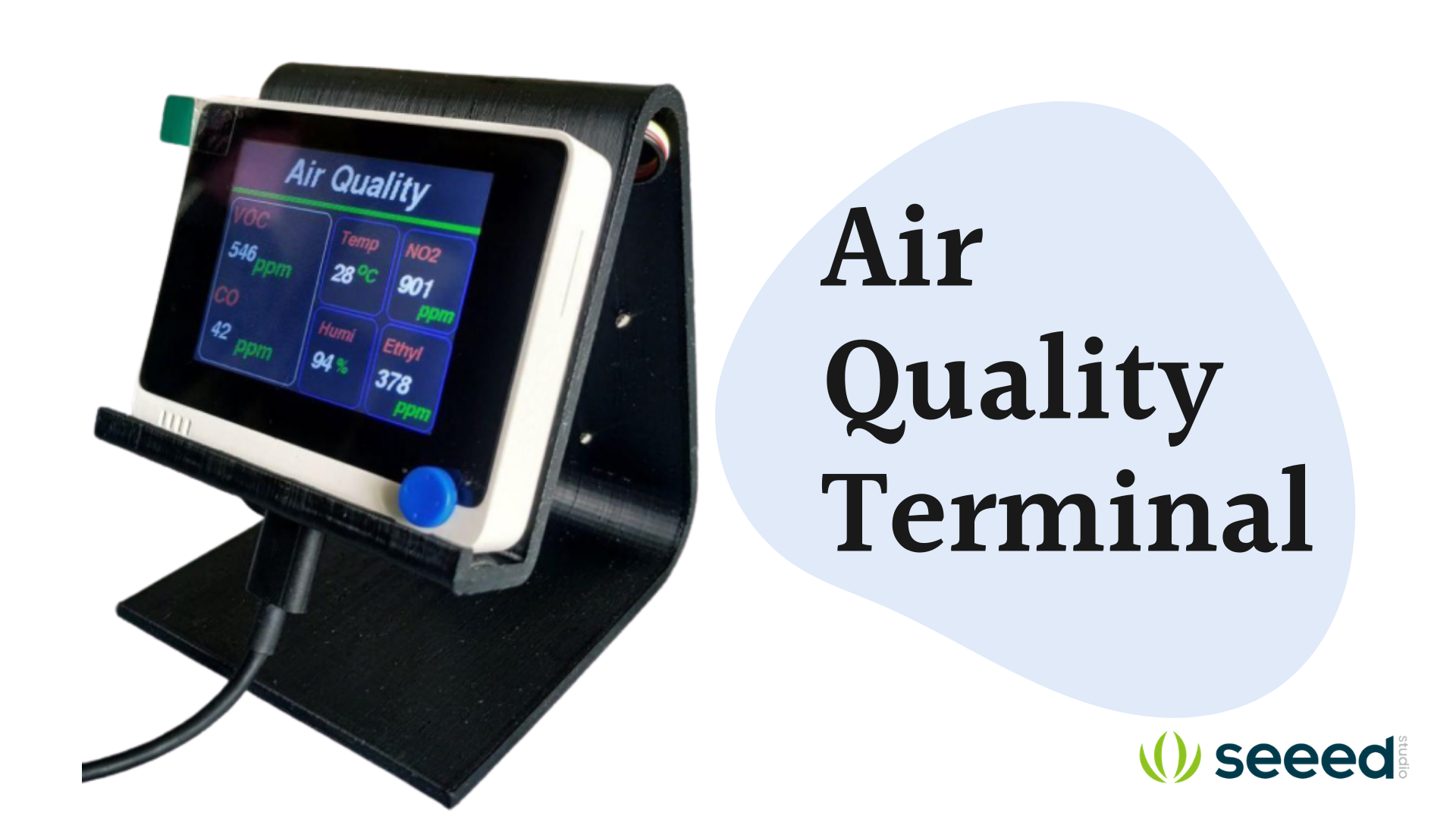
TL;DR: The Air Quality Terminal can be used as an indoor air quality meter to monitorVolatile organic compounds(VOCs),Carbon monoxide(CO), Nitrogen Dioxide(NO2), Ethyl alcohol(C2H5CH), Room Temperature and Humidity which can be used detect gas leaks and make alert..etc.
Breathing quality indoor air is critical for good health, Humans spend a significant amount of time indoors—either in the home, office or other types of buildings—where gases, chemicals and other pollutants can cause headaches, eye irritation, allergies and fatigue. Serious pollutants can cause certain types of cancers and other long-term health complications. (Src: https://pureaircontrols.com/why-indoor-air-quality-is-important-to-all-of-us/)
Common indoor air pollutants include:
When you breathe the harmful pollutants, it may stress your immune system that leads to several health conditions. The effects of poor indoor air quality on each person may differ based on their relative health and age. In general, this poor indoor air quality also leads to many allergy symptoms such as weakened immune systems and respiratory problems, and so on.
Specifically, the children are susceptible to so many health issues of the contaminated indoor air because their lungs are very smaller, and also they have to take many breaths during the entire day. If you suffer from the allergy sign or asthma-related issues will find in your home when you may have the polluted or more dust in your home. Even some other sources of air-related problems may also include such as remaining odours, improper ventilation, and natural changes such as new furnishings, a new pet, recent construction, or water damage.

One of the foremost steps to control the source of air pollution is finding out the cause of pollutants such as something like smoke,mold, or chemical off-gassing, and it also possible to eliminate from your house. However, this is one of the long-lasting and most effective methods of enhancing indoor air quality. Below are some of the best solutions to indoor air pollution that could be suggested by the EPA such as. Src: https://indoorbreathing.com/what-are-the-most-common-indoor-air-quality-complaints/
The Air Quality Terminal can be used as an indoor air quality meter to monitor Volatile organic compounds(VOCs),Carbon monoxide(CO), Nitrogen Dioxide(NO2), Ethyl alcohol(C2H5CH), Room Temperature and Humidity which can be used detect gas leaks and make alert..etc.
Carbon monoxide is a colourless and odourless gas which is not easily detectable by human senses and interferes with oxygen delivery throughout the body. Carbon monoxide causes headaches, dizziness, weakness, and nausea. Toxic amounts can lead to death.
Nitrogen dioxide, which is also a colourless and odourless gas, causes eye, nose and throat irritation, shortness of breath, and an increased risk for respiratory infections.
Volatile organic compounds (VOCs) - VOCs are organic chemicals that have a high vapour pressure at ordinary room temperature. Their high vapour pressure results from a low boiling point, which causes large numbers of molecules to evaporate or sublimate from the liquid or solid form of the compound and enter the surrounding air, a trait known as volatility. For example, formaldehyde, which evaporates from paint and releases from materials like resin, has a boiling point of only –19 °C (–2 °F).
Ethyl Alcohol- Ethanol, also called alcohol, ethyl alcohol and grain alcohol, is a clear, colourless liquid and the principle ingredient in alcoholic beverages like beer, wine or brandy. Because it can readily dissolve in water and other organic compounds, ethanol also is an ingredient in a range of products, from personal care and beauty products to paints and varnishes to fuel.
Here I will show you how to build the Air Quality Terminal step by step 🙂.
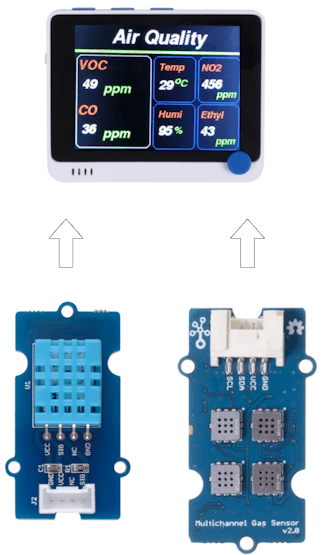
The Wio Terminal based ATSAMD51-based microcontroller with wireless connectivity supported by Realtek RTL8720DN and is equipped with a 2.4” LCD Screen, onboard IMU(LIS3DHTR), Microphone, Buzzer, microSD card slot, Light sensor, and Infrared Emitter(IR 940nm). Realtek RTL8720DN chip supports both Bluetooth and Wi-Fi providing the backbone for IoT projects.

Key Features
For more information go to https://www.seeedstudio.com/Wio-Terminal-p-4509.html.
For Setup, you can follow this wonderful guide provide by SeeedStudio. Get Started with Wio Terminal, anyway I'll go through quickly.Step 1.1: Download and Install the Arduino IDE: We are using Arduino IDE to programme the Wio Terminal, so we need to install it on our computer first. Click here to download Arduino IDEStep 1.2: Install Wio Terminal: Arduino IDE comes with official boards loaded from the Arduinio.cc so In order to program Wio Terminal we need to install the Wio Terminal Board packages and definition on the Arduino IDE.1.2.2: Add Additional Boards Manager URL: For that Open your Arduino IDE, click on File > Preferences, and copy below URL to Additional Boards Manager URLs
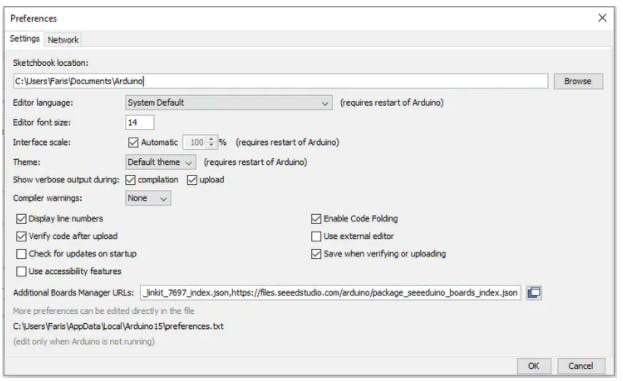
Note: If you have more additional boards manager URL's like me, make it separate with commas.1.2.3: Install Wio Terminal Board Manager: For that Click on Tools > Board > Board Manager and Search Wio Terminal in the Boards Manager.

1.2.4: Select your board and port: For that, you'll need to select the entry in the Tools > Board menu that corresponds to your Arduino. Selecting the Wio Terminal.

Select the serial device of the Wio Terminal board from the Tools -> Port menu. This is likely to be COM3 or higher (COM1 and COM2 are usually reserved for hardware serial ports). To find out, you can disconnect your Wio Terminal board and re-open the menu; the entry that disappears should be the Arduino board. Reconnect the board and select that serial port.
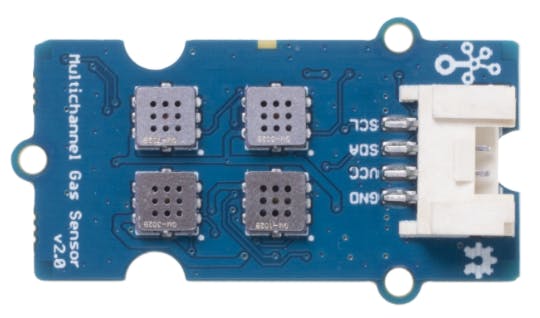
Features
Step 2.1. Connect Grove - Multichannel Gas Sensor V2 to port I2C of Wio Terminal And connect Wio Terminal to PC via a USB cable.Step 2.2. Download the Grove_Multichannel_Gas_Sensor_v2 Library from Github. And refer How to install library for Arduino.Step 2.3. Copy the code into Wio Terminal and upload. If you do not know how to upload the code, please check how to upload code.
Step 2.4. After uploading code open the serial monitor

Done, now we interfaced our first sensor and obtained the data.
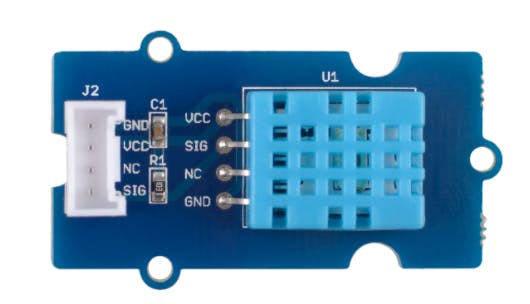
Step 1. Download the Seeed DHT library from Github.Step 2. Connect DHT11 sensor to Wio TerminalStep 3. Refer How to install library for Arduino.Step 4. Copy the code into Wio Terminal and upload. If you do not know how to upload the code, please check how to upload code.
Step 5. After uploading code open the serial monitor

Step 1. Connect both Multichannel Gas sensor and DHT11 sensor to Wio TerminalStep 2. Copy the code into Wio Terminal and upload.
Step 3. After uploading code open the serial monitor
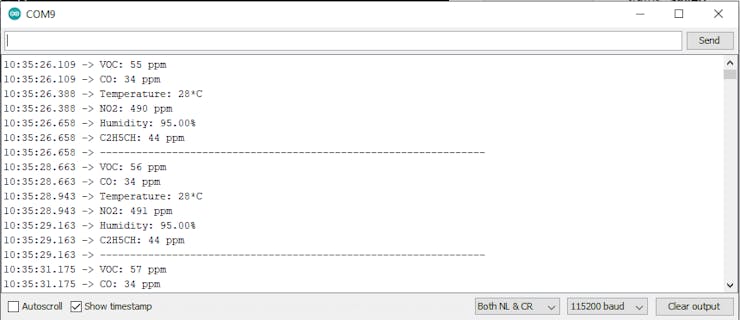
I Designed simple UI with Draw.io, it's an awesome online tool to create diagrams very quickly. 🤗

The RED colours are the sensor value names, The GREEN colours are the sensorvalues.
There is a video tutorial show from Wio Terminal Classroom! and Lakshantha will explain how to use the LCD: Wio Terminal Classroom #2 | Drawing Shapes on LCD.By default, the TFT LCD Library is included inside the Wio Terminal Board Library. Hence, there is no need to download the TFT LCD library again.First, we can start with the heading. Air Quality
Code review
FF# where # is a number determined by looking at the list in the Free_Fonts.hTo draw Strings on the LCD screen:
where string is the text string, and (poX, poY) is the starting coordinates.Here, we set the cursor on the 70 and 10 and drawstring "Air Quality" as white colour.
To draw a line between two points on the LCD screen:
where the line starts drawing from (x0, y0) to (x1, y1) and colour.Here, we draw a line horizontally with green colour.
Display output:

Next, we are daring rectangles for sensor values To draw or fill a rounded rectangle on the LCD screen for
where (x, y) is the starting coordinate, w and h for width and height of rectangles, r for the corner radius and colour. So.
Here, we drawing rectangles for the sensor values
Display output:

next, we need to add theappropriate sensor label name for that,
Here, we using the drawString function to add the sensor label name.display VOC and ppm label text
display CO and ppm label text
display Temperature and oc label text
display NO2 and ppm label name
display Humidity and % label name
display Ethyl and ppm label name
Display output
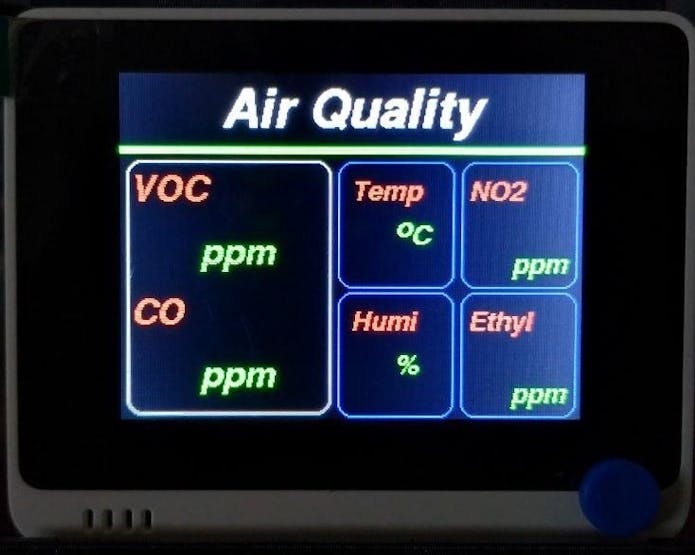
Now we converted our design into code. 🥳
Next, we can display the sensor readings within the UI we developed. The Final Code
Here. we are reading the sensor values and displaying it with 2-sec delay.code reviewReading and displaying the VOC value
Reading and displaying the CO value
Reading and displaying the Temperature value
Reading and displaying the NO2 value
Reading and displaying the Humidity value
Reading and displaying the C2H5CH value
Output Display
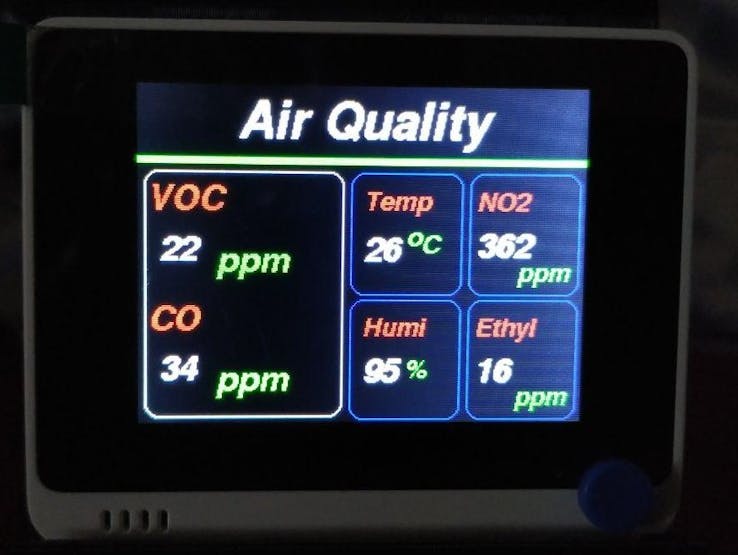
I used Autodesk Fusion360 to design the stand.
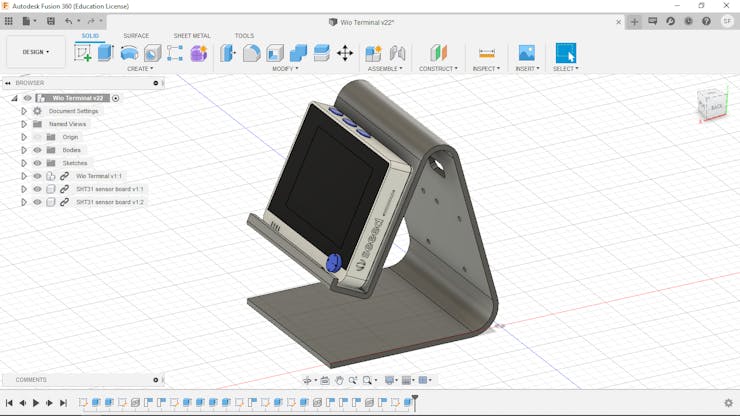
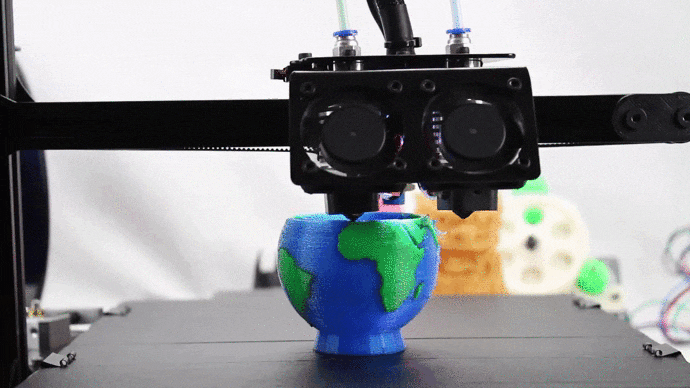
I used black ABS filament to print the stand.
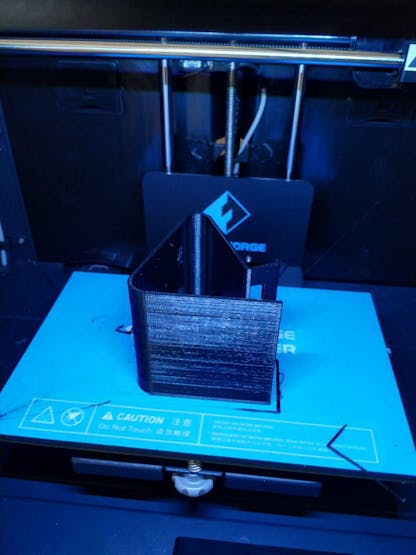

The final part is, assembling
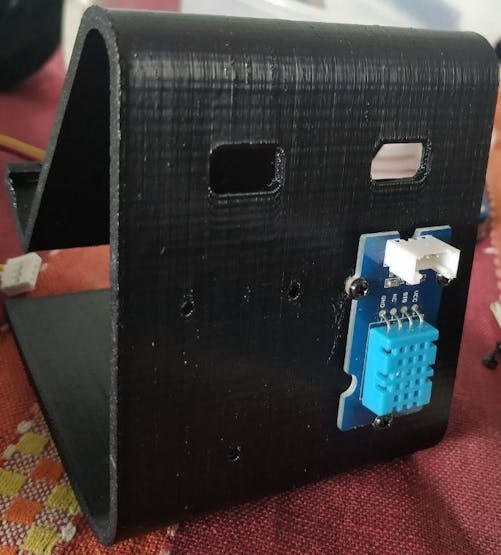
. First I connected DHT11 and screwed.

_yGJTb0UMWO.jpg?auto=compress%2Cformat&w=740&h=555&fit=max)


Future PlanAir Quality Terminal Project is not completed yet I was planning to push the data to cloud and do some analytics base on the value. 😎. Please share your valuable comment and feedback!
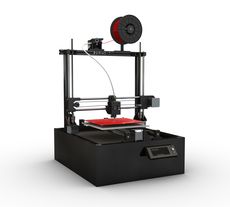
19.12
Size: SQuantity: 6
There are 6 items in your cart.
Total products: 114.72
Taxes 0.00
Total: 121.72 (tax excl.)

19.12
Size: SQuantity: 6
There are 6 items in your cart.
Total products: 114.72
Taxes 0.00
Total: 121.72 (tax excl.)
